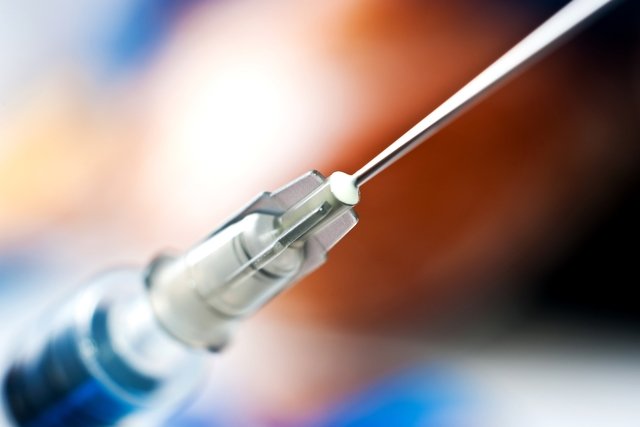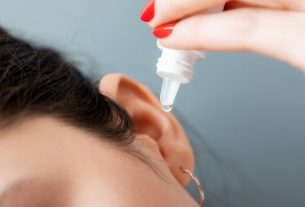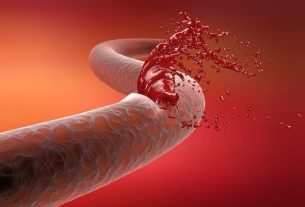A needle stick is a serious but relatively common accident that usually happens in the hospital, but can also happen in everyday life, especially if you are walking barefoot on the street or in public places, as a lost needle may be lost.
This type of accident can increase the risk of transmitting diseases, such as HIV, hepatitis B or C, and therefore some immediate care after a needle stick that helps reduce the risk of disease is washing the skin with soap and water, not squeeze the skin and seek hospital or health care immediately.
Therefore, the doctor must assess the health risks, how the accident occurred, affected area, depth of the injury, presence of blood, and request blood tests for HIV, hepatitis B and C. In some cases, the doctor may indicate post-exposure prophylaxis, with antiretroviral drugs or vaccination for hepatitis B.

What to do in case of a needlestick accident
In the case of a needlestick accident, what you should do is:
- Wash the skin with soap and water for 15 minutes. An antiseptic product can also be used, however, studies indicate that this does not seem to reduce the risk of catching a disease;
- Do not use irritating products on sitesuch as ether, sodium hypochlorite (bleach) or benzine, for example;
- Do not squeeze the area where the needle stick occurredmaking cuts or applying injections, or sucking the skin, as this may increase the area of skin exposed to the infectious agents present in the needle;
- Wash lips, oral and nasal cavities thoroughly with water or saline solutionif the accident occurred on mucous membranes;
- Remove contact lenses and wash eyes with plenty of water or saline solutionfor 15 minutes, if the accident occurred in the eye;
- Identify whether the needle has been previously used by someone who may have a communicable disease. If this is not possible, it must be considered that the needle was used;
- Go to the hospital if the needle has been used before, to do blood tests and diagnose any disease that needs to be treated.
These recommendations apply both to accidents involving needles used by people and needles used by animals in veterinary clinics.
Where to take the tests?
In all cases of a needle stick accident, you must go to the hospital or health center immediately, so that HIV, hepatitis B and C tests can be carried out, and the doctor can assess the person’s vaccination status.
Some diseases can take a few months to be identified in blood tests and, therefore, it is advisable to go to the hospital or health center to repeat the tests after 6 weeks, 3 months and 6 months, especially if the tests were always negative.
In the case of healthcare professionals who have had an accident with a needle or sharp material, the occupational safety and medicine service and the hospital infection control service should be sought.
Main risks of needle sticks
There are several viruses that can be transmitted by a needle, even if it has not yet been used, as it can transport microorganisms present in the air directly into the blood vessels.
However, the highest risk situations occur when the needle has already been used by another person, especially when their history is not known, as diseases such as HIV and hepatitis B or C may be transmitted. Check out the symptoms of HIV, Hepatitis B or Hepatitis C that may arise.
Post exposure prophylaxis
Post-exposure prophylaxis (PEP) is a treatment that may be indicated by a doctor to prevent the risk of HIV or hepatitis B infection after a needle stick accident.
This type of treatment must be evaluated by the doctor on an individual basis, taking into account the affected area, size and depth of the bite, in addition to whether the source of exposure is positive for HIV or hepatitis B.
Post-exposure prophylaxis (PEP) for HIV is recommended to be started as soon as possible, 2 hours after the accident, or no later than 72 hours after, with a combination of antiretroviral drugs such as zidovudine (AZT), lamivudine, indinavir or nelfinavir, taken for 28 consecutive days.
As for hepatitis B, the doctor may recommend the vaccination schedule for hepatitis B, in the case of unvaccinated people, who have the complete vaccination schedule or who were not immunized after complete vaccination.
Furthermore, during the 6 to 12 weeks after the needle accident, it is recommended that the person use a condom in all sexual relations, and not donate blood, plasma, semen or organs, in addition, in the case of breastfeeding women, stop breastfeeding.
How to avoid a needle stick
To avoid an accidental needle stick, you must take some special precautions, such as:
- Avoid going barefoot on the street or in public places, especially on grass;
- Dispose of needles in an appropriate container, if they need to be used at home to administer insulin, for example;
- Deliver the needle container to the pharmacy whenever it is 2/3 full;
- Avoid capping a needle that has already been used.
These precautions are especially important for healthcare professionals, but also for people who come into frequent contact with needles at home, especially in the case of diabetes treatment, with insulin, or administration of heparin.
People who are most at risk of an accidental needle stick include healthcare workers, clinical laboratory workers, and caregivers of people with chronic illnesses, especially diabetes or heart problems.
Bibliography
- FEDERAL UNIVERSITY OF MINAS GERAIS – VETERINARY SCHOOL – VETERINARY HOSPITAL PHARMACY. Procedure in case of accidents. Available at: <https://www.vet.ufmg.br/ARQUIVOS/FCK/file/ITT%20farmacia%20015%20-%20Procedimento%20em%20caso%20de%20acidentes.pdf>. Accessed on April 3, 2023
- WORLD GASTROENTEROLOGY ORGANISATION PRACTICE GUIDELINES. Needle Accidents and Accidental Exposure to Blood. Available at: <https://universidadefbg.com.br/arq/guidelines/01.pdf>. Accessed on April 3, 2023
- MINISTRY OF HEALTH. Exposure to Biological Materials. 2006. Available at: <https://bvsms.saude.gov.br/bvs/publicacoes/protocolo_expos_mat_biologicos.pdf>. Accessed on April 3, 2023
- CDC – CENTERS FOR DISEASE CONTROL AND PREVENTION. What to do following a sharps injury. 2019. Available at: <https://www.cdc.gov/nora/councils/hcsa/stopsticks/whattodo.html>. Accessed on April 3, 2023
- NHS – NATIONAL HEALTH SYSTEMS. What should I do if I injure myself with a used needle?. 2021. Disponível em: <https://www.nhs.uk/common-health-questions/accidents-first-aid-and-treatments/what-should-i-do-if-i-injure-myself-with-a-used-needle/>. Acesso em 03 abr 2023
- ANA. Needlestick prevention guide. 2002. Disponível em: <https://www.who.int/occupational_health/activities/2needguid.pdf>. Acesso em 14 mar 2019
- ZEHNDER, Nichole G.. What Should I Do If I Get a Needlestick?. The Hospitalist. 10.ed; 2010
- NIOSH. How to Prevent Needlestick and Sharps Injuries. 2012. Available at: <https://www.cdc.gov/niosh/docs/2012-123/pdfs/2012-123.pdf>. Accessed on March 14, 2019
- NIOSH. What Every Worker Should Know: How to Protect Yourself From Needlestick Injuries. Available at: <https://www.who.int/occupational_health/activities/6nioshbhp.pdf>. Accessed on March 14, 2019

Sign up for our newsletter and stay up to date with exclusive news
that can transform your routine!
Warning: Undefined array key "title" in /home/storelat/public_html/wp-content/plugins/link-whisper-premium/templates/frontend/related-posts.php on line 12
Warning: Undefined array key "title_tag" in /home/storelat/public_html/wp-content/plugins/link-whisper-premium/templates/frontend/related-posts.php on line 13



